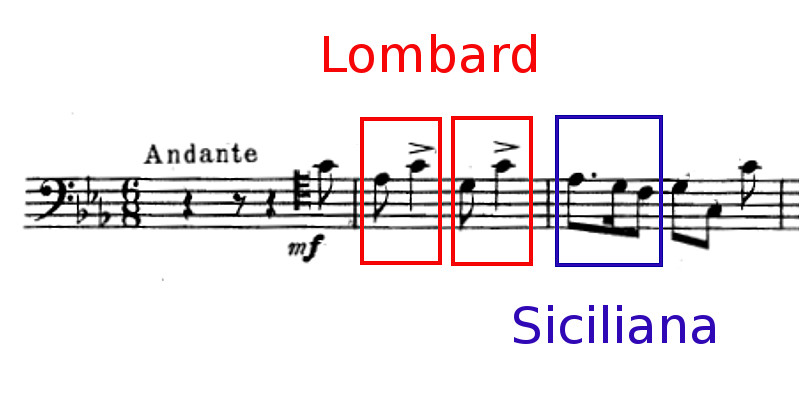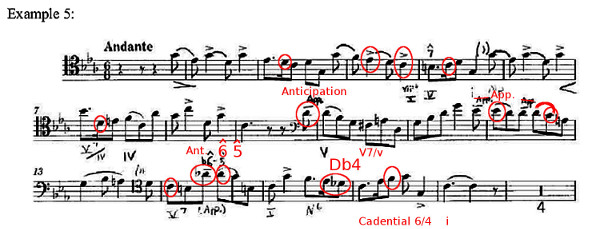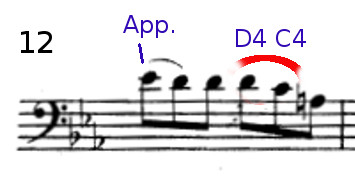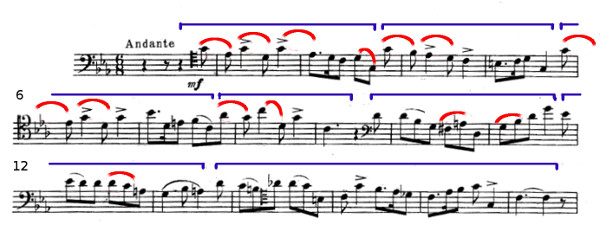
Carl Maria von Weber.
卡尔·玛丽亚·冯·韦伯。
https://en.wikipedia.org/wiki/Carl_Maria_von_Weber
1.
欢迎,我是泰瑞·尤厄尔。这是您在韦伯的行板和匈牙利回旋曲中的行板视频。
I mentioned in the prior video some of the Hungarian rhythmic aspects of the Rondo. The Hungarian aspects expressed in the Andante are quite different. The Lombard rhythm, short-long, starts the melody in measure two and is repeated many times. Portions of this movement refer to the Siciliana, which is a 6/8 dance with the dotted eighth, sixteenth, and eighth note rhythm.
2. 我在之前的视频中提到了迴旋曲的一些匈牙利节奏方面。行板中表达的匈牙利方面是完全不同的。伦巴第节奏,先短後长,以第二小节开始旋律并重复多次。这个乐 章的一部分是指西西里亚那舞曲,这是一个 6/8 的舞蹈,带有附點八分音符、十六分音符和八分音符的节奏。

You can see that rhythm in measures three and five. Now, neither of these rhythmic devices are associated solely with the Hungarian or Gypsy idioms, however, they set the mood that this is a composition that departs from the typical Common Practice composition. The exoticism or “otherness” of the Andante is most persuasively conveyed by its insistence on rhythmic and dissonant stresses off the beat. Notice in the opening that Weber provides accents on the “off beats” of the Lombard rhythms. These rhythms are found in measures two and four and later in the composition. Furthermore the placement of dissonance often avoids strong metrical positions.
3. 您可以在第三和第五小节中看到这种节奏。现在,这些节奏型態都不是仅仅与匈牙利语或吉普赛语的习语相关联,但是,它们卻营造出一种情绪,即这是一首不同于 典型的常用作曲的作曲。行板的异国情调或“外來的”最有说服力地体现在它坚持节拍的节奏和不和谐的压力。注意韦伯提供的曲子开场 時强调伦巴第节奏的弱拍上。这些节奏出现在第二小节和第四小节以及后来的作曲中。此外,不和谐的位置通常会避免强烈的格律位置。
Let’s examine this more closely by studying the analysis by Dr. Melissa Kritzer on page 76 of her dissertation.
4. 让我们通过研究 Melissa Kritzer 博士在她的论文第 76 页上的分析来更仔细地研究这一点。

My markings are in red in Example 5.

Measure 12 provides a temporary reprieve and I give stresses on the beat here. There is a real appoggiatura on the downbeat and then I play the next beat with the same stresses and slurred articulation. Aside from the traditional use of dissonance in the Siciana rhythm and measure 12, it is important to convey the usual placements of these dissonances to the listener.
6. 第 12 小节提供了暂时的缓和,我在这里强调节拍。在强拍上有一个真正的倚音appoggiatura,然后我用同样的重音和清晰的发音演奏下一个节拍。除了在 西西里舞曲节奏和第 12 小节中使用不和谐音的传统用法外,向听众传达这些不和谐音的通常位置也很重要。
The Db4 in measure 15 (Example 5) is given over the chord of a Neapolitan Sixth. Technically this Db is a consonance with the Neapolitan Sixth. However, the note is so unusual and striking at that point in harmony that I have circled note again showing its emphasis on the offbeat. Although my analysis differs from Dr. Kritzer’s this in no way diminishes the fine research she has done. I concur with her observations that many of the dissonances are strategically placed off the beat in this theme to enhance the exotic and unexpected nature of this melody.
7. 第 15 小节(示例 5)中的 Db4 是在拿坡里六和弦上给出的。从技术上讲,这个 Db 与拿坡里六和弦是和諧的。然而,这个音符是如此不同寻常,在和谐的那一点上是如此引人注目,以至于我再次圈出了音符,表明它对另类的强调。尽管我的分析与 Kritzer 博士的不同,但这绝不会削弱她所做的精细研究。我同意她的看法,即在这个主题中,许多不和谐音被計畫好的置于节拍之外,以增强这个主题的异国情调和意想不 到的性质旋律。

Weber presents hypermeter in this melody. Hypermeter is a combination of measures into a larger unit. The blue brackets indicate that two 6/8 measures are combined; the first measure with the Lombard and the second with Siciliana rhythms. Performing the melody (measures 1-13) with 12/8 measures instead of two 6/8 measures will enhance the expression. Thus, each two measures features a slight crescendo and decrescrendo with the climax occurring on the downbeat of the second measure. The pickup to measure 14 breaks with the previous pattern and is presented as a four measure phrase. I add the slurs in the figure to enhance the expression of the melody and also to provide more emphasis to the accents. Tonguing, rather than slurring into the accent, gives the note more emphasis. I tongue the downbeats in measures 7 and 9 to increase my accuracy on those notes. In measure 12 I slur from the appoggiatura downbeat and repeat the same gesture in the next beat from D4 to C4.
8. 韦伯在这首旋律中呈现了Hypermeter。 Hypermeter是指将幾個小節组合成一个更大的单元。蓝色括号表示合并了两个 6/8 小節;第一小节用 倫巴第節奏Lombard,第二小节用西西里亞納 Siciliana 节奏。用 12/8 小节而不是两个 6/8 小节演奏旋律(第 1-13 小节)将增强表现力。因此,每两个小节都有轻微的渐强和渐弱,高潮出现在第二小节的强拍上。
The Andante movement is in variation form, with four presentations of the theme. In presentations 2 and 4, starting at measures 22 and 60, the bassoon is an accompanist and will need to fit the rapid notes to the melody given in the strings. Remember to follow the hypermeter expression of the melody that I have note previously.
10. 行板樂章是变奏形式,有四个主题呈现。在 2 和 4 的呈現中,从第 22 和 60 小节开始,大管是伴奏者,需要将快速音符与弦乐中的旋律相匹配。记得按照我之前记下的旋律的以hypermeter的方式來表達。
The low register articulation can be tricky in this movement.
11. 在这个樂章中,低音部份的发音可能很棘手。

It is even more of a problem in the Weber concerto.
12. 这在韦伯协奏曲中更是一个问题。

The key to both is to use
the same air stream and embouchure for the articulated notes as one would use
for slurring the same notes. For example, in measure 28 let’s first practice
this section slurred.
I provide musical contrast in measures 39-55 much
as I did in the pickup in measure 9 continuing on to measure 13. Longer and more
lyrical notes are called for here. Notice that Weber did not include as many
accents, and in measure 50 the accents are more like expressive appoggiaturas
rather than unexpected exotic notes. Here is a portion of that passage.
Copyright (c) 2016-22 by Terry B. Ewell. All rights reserved.
版權所有 © 2016-22泰瑞·B·尤厄爾(Terry B. Ewell)。保留所有權利。